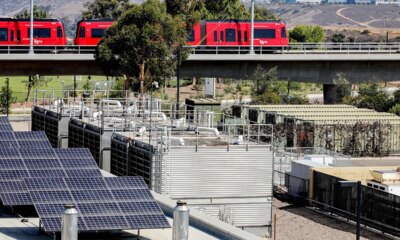Get ready: The Great California Shakeout is coming Thursday.
California
California’s annual earthquake drill happens Thursday. Here are details


Ed Lee, left, the late San Francisco mayor, and others participate in the Great California Shakeout annual earthquake drill as they “drop, cover and hold on” at an elementary school in the city in October 2011.
The event is an annual earthquake drill, aimed at increasing public awareness about what to do during major shaking. Millions of people around the world have signed up for the drills, which are scheduled for 10:16 a.m. local time.
“The best protective action you can take during an earthquake is to drop down, get under your desk, cover your head and hold on to something that’s sturdy, like the leg of a table,” said state geologist Jeremy Lancaster, with the California Geological Survey, during a presentation Monday.
Article continues below this ad
The Great ShakeOut website also provides additional preparation tips, like securing items that might fall during earthquakes, creating family disaster plans and restocking emergency supply kits.
The drill occurs a day before the 36th anniversary of the devastating 6.9-magnitude Loma Prieta earthquake, which was centered near Santa Cruz and caused widespread damage, including to the Bay Bridge and the Marina district.
What’s happening Thursday?
At 10:16 a.m., the MyShake app will buzz for millions of Californians. The alert will display an infographic instructing users to drop, cover and hold on. It also includes an audio message, indicating that it is an earthquake drill.
The U.S. Geological Survey’s ShakeAlert system, which underlies the MyShake app, provides warning in advance of earthquake shaking by detecting seismic waves. People near the epicenter may receive little or no advance warning, however.
Article continues below this ad
What if I don’t get the test alert?
Users should make sure they have the latest version of the MyShake app installed, and also have location services and notifications enabled.
While MyShake encourages users to practice the drill, those who don’t want to receive the message can temporarily turn off app notifications.
Who’s participating?
More than 53.2 million people worldwide have signed up for the event, according to the ShakeOut website on Tuesday. There are over 10 million participants registered across California. About 1.5 million people have signed up in the Bay Area.
Article continues below this ad
BART is planning to trigger its ShakeAlert early warning earthquake system at 10:16 a.m., which will cause trains to automatically slow down to 27 mph and come to a brief stop.
BART will also make a systemwide public announcement encouraging riders to be prepared for earthquakes. The transit agency is also testing internal communications systems and simulating damage inspections.
What else is going on this week on the earthquake front?
This week, the California Governor’s Office of Emergency Services is hosting a statewide tour with an earthquake simulation trailer and providing quake preparedness information. This simulator is akin to the California Academy of Science’s Shake House.
Article continues below this ad

California
Neil Thwaites promoted to ‘Vice President of Global Sales & California Commercial Performance’ for Alaska Airlines and Hawaiian Airlines – Alaska Airlines, Hawaiian Airlines and Horizon Air

Thwaites will lead the strategy and execution of all sales activities for the combined Alaska Airlines and Hawaiian Airlines team. His responsibilities include growing indirect revenue on Alaska’s expanding international and domestic network, as well as expanding Atmos for Business, a new program designed for small- and medium-sized companies.
Thwaites joined Alaska Airlines in January 2022 as regional vice president in California. Since stepping into the role, Thwaites has significantly sharpened the airline’s focus and scale in key markets and communities across the state, strengthening Alaska’s position as we continue to grow in California. He will continue to be based at the company’s California offices in Burlingame. The moves take effect Dec. 13, with Thwaites also continuing to lead his current California commercial planning and performance function in addition to Global Sales.
Prior to Alaska, Thwaites worked in multiple positions within the airline industry, including a decade holding roles in London, New York, and Los Angeles for British Airways (a fellow oneworld member); most recently as ‘VP, Sales – Western USA’, where he was responsible for market development strategy and indirect revenue for both British Airways and Iberia across the western U.S.
Thwaites is originally from the United Kingdom and graduated from the University of Brighton with a double honors degree in Business Administration & Law.
California
Tiny tracker following monarch butterflies during California migration

SAN FRANCISCO (KGO) — When this monarch butterfly hits the sky it won’t be traveling alone. In fact, an energetic team of researchers will be following along with a revolutionary technology that’s already unlocking secrets that could help the entire species survive.
“I’ve described this technology as a spaceship compared to the wheel, like using a using a spaceship compared to the invention of the wheel. It’s teaching us so, so much more,” says Ray Moranz, Ph.D., a pollinator conservation specialist with the Xerces Society.
Moranz is part of a team that’s been placing tiny tracking devices on migrating monarchs. The collaboration is known as Project Monarch Science. It leverages solar powered radio tags that are so light they don’t affect the butterfly’s ability to fly. And they’re allowing researchers to track the Monarch’s movements in precise detail. With some 400 tags in place, the group already been able to get a nearly real time picture of monarch migrations east of the Rockies, with some populations experiencing dramatic twists and turns before making to wintering grounds in Mexico.
“They’re trying to go southward to Mexico. They can’t fight the winds. Instead, some of them were letting themselves be carried 50 miles north, 100 miles north, 200 miles the wrong way, which we are all extremely alarmed by and for good reason. Some of these monarchs, their migration was delayed by two or three weeks.
According to estimates, migrating monarch populations have dropped by roughly 80% or more across the country. And the situation with coastal species here in California is especially dire. Blake Barbaree is a senior scientist with Point Blue Conservation Science. He and his colleagues are tracking Northern California populations now clustered around Santa Cruz.
MORE: Monarch butterflies to be listed as a threatened species in US
“This year, there’s it’s one of the lowest, populations recorded in the winter. And the core zones have been in Santa Cruz County and up in Marin County. So we’ve undertaken an effort to understand how the monarchs are really using these different groves around Santa Cruz by tagging some in the state parks around town,” Barbaree explains.
He says being able to track individual monarchs could help identify microhabitats in the area that help them survive, ranging from backyard pollinator gardens to protected open space to forest groves.
“So we’re really getting a great insight to how reliant they are on these big trees, but also the surrounding area and people’s even backyards. And then along the way around the coast, how they’re transitioning among some of these groves. And we’re looking for some of the triggers for those movements. Right. Why are they doing this and what’s what’s driving them to do that? So those questions are still a little bit further out as we get to analyze some more some more of the data,” he believes.
And that data is getting even more precise. The tags, developed by Cellular Tracking Technologies, can be monitored from dedicated listening stations. But the company is also able to crowdsource signals detected by cellphone networks on phones with Bluetooth connectivity and location access activated. And they’ve also helped develop an app that allows volunteers, citizen scientists, and the general public to track and report Monarch locations themselves using their smartphones.
CEO Michael Lanzone says the initial response has been overwhelming.
MORE: New butterflies introduced in SF’s Presidio after species went extinct in 1940s
“We were super surprised to see 3,000 people download the monarch app. It’s like, you know, but people really love monarchs. There’s something that people just relate to,” says Lanzone who like many staffers at Cellular Tracking Technologies, has a background in wildlife ecology.
A number of groups are pushing to have the monarchs designated nationally as a threatened species. If that ultimately happens, researchers believe the tracking data could help put better protections in place.
“They’re highly vulnerable to, you know, some of the different things that that that we as humans do around using pesticides and also potentially cutting, you know, cutting down trees for various reasons. Sometimes they’re for safety and sometimes it’s, you know, for development. But so having an understanding of how we can do those things more sensibly and protect the places that they need the most,” says Point Blue’s Barbaree.
And it’s happening with the help of researchers, citizen scientists, and a technology weighing no more than a few grains of rice.
The smartphone app is called Project Monarch Science. You can download it for free and begin tracking.
Copyright © 2025 KGO-TV. All Rights Reserved.
California
Poisonings from ‘death cap’ mushrooms in California prompt warning against foraging

After a string of poisonings from “death cap” mushrooms — one of them fatal — California health officials are urging residents not to eat any foraged mushrooms unless they are trained experts.
Doctors in the San Francisco Bay Area have blamed the wild mushroom, also called Amanita phalloides, for 23 poisoning cases reported to the California Poison Control System since Nov. 18, according to Dr. Craig Smollin, medical director for the system’s San Francisco division.
“All of these patients were involved with independently foraging the mushrooms from the wild,” Smollin, who is a professor of emergency medicine at the University of California, San Francisco, said at a news conference Tuesday. “They all developed symptoms within the first 24 hours, including nausea, vomiting, diarrhea and abdominal pain.”
Smollin said some of the patients were parts of cohorts that had consumed the same batch of foraged mushrooms. The largest group was about seven people, he said.
All of the patients were hospitalized, at least briefly. One died. Five remain in hospital care. One has received a liver transplant, and another is on a donation list awaiting a transplant, Smollin said. The patients are 1½ to 56 years old.
Mushroom collectors said death cap mushrooms are more prevalent in parts of California this season than in years past, which could be driving the increase in poisonings.
“Any mushroom has years that it’s prolific and years that it is not. … It’s having a very good season,” said Mike McCurdy, president of the Mycological Society of San Francisco. He added that the death cap was one of the top two species he identified during an organized group hunt for fungi last week, called a foray.
In a news release, Dr. Erica Pan, California’s state public health officer, warned that “because the death cap can easily be mistaken for edible safe mushrooms, we advise the public not to forage for wild mushrooms at all during this high-risk season.”
Dr. Cyrus Rangan, a pediatrician and medical toxicologist with the California Poison Control System, said the “blanket warning” is needed because most people do not have the expertise to identify which mushrooms are safe to eat.
Still, he said, “it’s rare to see a case series like this.”
The California Poison Control System said in a news release that some of the affected patients speak Spanish and might be relying on foraging practices honed outside the United States. Death cap mushrooms look similar to other species in the Amanita genus that are commonly eaten in Central American countries, according to Heather Hallen-Adams, the toxicology chair of the North American Mycological Association. Because death caps are not often found in that region, foragers might not realize the potential risk of lookalikes in California, she said.
Anne Pringle, a professor of mycology at the University of Wisconsin-Madison, said there is a litany of poisoning cases in which people misidentify something because their experience is not relevant to a new region: “That’s a story that comes up over and over again.”
Over the past 10 years, mushroom foraging has boomed in the Bay Area and other parts of the country. At the same time, information resources about mushroom toxicity — reliable and otherwise — have proliferated, as well, including on social media, phone apps and artificial intelligence platforms. Experts said those sources should be viewed with skepticism.
Longtime mushroom hunters maintain that the practice can be done safely. McCurdy, who has collected and identified mushrooms since the 1970s, said he bristled at the broad discouragement of foraging.
“No, that’s ridiculous. … After an incident like this, their first instinct is to say don’t forage,” he said. “Experienced mushroom collectors won’t pay any attention to that.”
But McCurdy suggested that people seek expertise from local mycological societies, which are common in California, and think critically about the sources of information their lives may be relying on.
Pringle and McCurdy both said they have seen phone apps and social media forums misidentify mushrooms.
“I have seen AI-generated guidebooks that are dangerous,” Pringle said.
The death cap is an invasive species that originated in Europe and came to California in the 1930s, most likely with imported nursery trees. The mushroom is usually a few inches tall with white gills, a pale yellow or green cap and often a ring around the base of its stalk.
The species is found across the West Coast and the Eastern Seaboard, as well as in Florida and Texas, according to Hallen-Adams, who is also an associate professor of food science at the University of Nebraska-Lincoln.
In California, it typically grows near oak trees, though occasionally pines, too. The mushroom’s body is typically connected to tree roots and grows in a symbiotic relationship with them.
The toxin in death cap mushrooms, called amatoxin, can damage the kidneys, liver and gastrointestinal tract if it is ingested. It disrupts the transcription of genetic code and the production of proteins, which can lead to cell death.
Hallen-Adams said the U.S. Poison Centers average about 52 calls involving amatoxin each year, but “a lot of things don’t get called into poison centers — take that with a grain of salt.”
Amatoxin poisoning is not the most common type from mushrooms, but it is the most dangerous, she added: “90% of lethal poisonings worldwide are going to be amatoxin.”
It takes remarkably little to sicken a person.
“One cubic centimeter of a mushroom ingested could be a fatal dose,” Hallen-Adams said.
Symptoms of amatoxin poisoning often develop within several hours, then improve before they worsen. There is no standard set of medical interventions that doctors rely on.
“It’s a very difficult mushroom to test for,” Rangan said, and “also very difficult to treat.”
One drug that doctors have leaned on to treat some of the California patients — called silibinin — is still experimental and difficult to obtain.
“All of our silibinin comes from Europe,” Hallen-Adams said.
Death cap mushrooms have continued to grow abundantly since their introduction, and Pringle’s research has shown that the species can reproduce bisexually and unisexually — with a mate or by itself, alone — which gives it an evolutionary advantage.
“If Eve can make more of herself, she doesn’t need Adam,” Pringle said. “One of the things I’m really interested in is how you might stop the invasion, how you might cure a habitat of its death caps. And I have no solutions to offer you at the moment.”
-

 Alaska5 days ago
Alaska5 days agoHowling Mat-Su winds leave thousands without power
-

 Politics1 week ago
Politics1 week agoTrump rips Somali community as federal agents reportedly eye Minnesota enforcement sweep
-
Ohio1 week ago
Who do the Ohio State Buckeyes hire as the next offensive coordinator?
-

 News1 week ago
News1 week agoTrump threatens strikes on any country he claims makes drugs for US
-

 Texas5 days ago
Texas5 days agoTexas Tech football vs BYU live updates, start time, TV channel for Big 12 title
-

 World1 week ago
World1 week agoHonduras election council member accuses colleague of ‘intimidation’
-

 Washington2 days ago
Washington2 days agoLIVE UPDATES: Mudslide, road closures across Western Washington
-

 Iowa4 days ago
Iowa4 days agoMatt Campbell reportedly bringing longtime Iowa State staffer to Penn State as 1st hire























